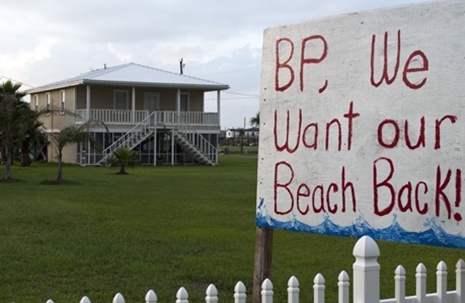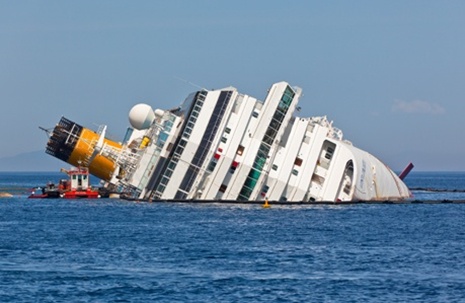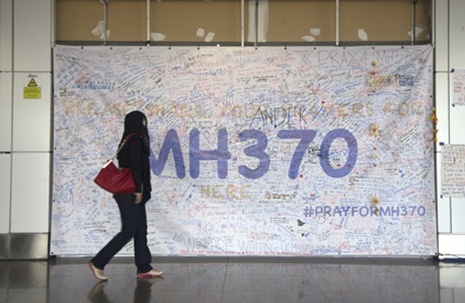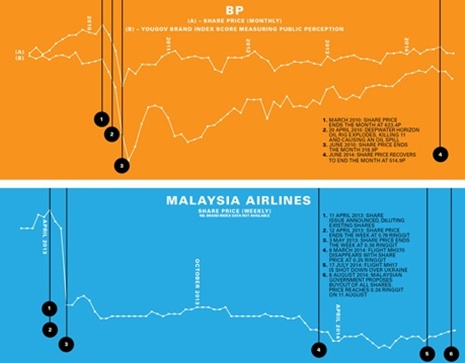Can a brand survive a crisis long term?
While Malaysia Airlines mulls a rebrand following two catastrophic plane crashes others have decided to persevere and rebuild following a disaster. But what are the long term effects?
Malaysia Airlines and its passengers have suffered gravely in recent months. The disappearance and ongoing search for flight MH370 followed by the shooting down of flight MH17 four months later have caused untold damage, both emotionally to all those involved and also to the long-term reputation of the business.
After initial talks of a rebrand, Khazanah, Malaysia’s state-owned investment fund and the airline’s majority shareholder, plans to delist the business from the stock market ahead of a “complete overhaul” and major restructure.
But is a rebrand the right move after a disaster? Should marketers stick to their original strategy in the hope that it will protect their brand long term? And can they recover from such crises? BP’s share price fell dramatically following the Deepwater Horizon disaster in 2010 (see graph below - click here for a full-size version[1]) but has recovered to an extent, while Primark’s profits increased 44 per cent last year despite the Rana Plaza clothes factory collapse in April 2013.
While some believe Malaysia Airlines’ future hinges on its ability to build a “new airline that can win customer trust”, others say it will take more than a new colour scheme to repair the damage. The Financial Times suggested this week that over-staffing and unprofitable routes are more fundamental business problems.
At the time of writing, the company’s share price was higher than before MH370 disappeared, while its biggest recent fall was actually the result of new shares being issued in 2013 (see graph above[2]). A rebrand at this stage could be more detrimental to the long-term stability of the Malaysian government-backed business, according to Natalie Cowen, head of marketing at train company East Coast.
“A rebrand is not the answer,” she insists. “Malaysia Airlines doesn’t have anything to hide so from a brand perspective it needs to focus on reassuring people that it is dealing with the situation and doing whatever it can.”
Rebecca Gudgeon, senior member of the Public Relations Consultants Association and managing director of corporate and financial at Grayling, agrees that while Malaysia Airlines’ intentions may be sincere, the move could be misinterpreted.
“Trying to distance itself from the situation too quickly is almost like denying it happened and that for a brand carries inherent risks,” she says. “A brand can almost stand as a memorial for people who have died and I think moving on too fast and trying to disassociate itself from its old identity could be misconstrued as it wanting to disassociate from any responsibility, and that doesn’t bode well for the organisation’s values.”
Marketing Week columnist Mark Ritson says the airline would be wise to repair its battered image[3] rather than uprooting the business and losing a “strong heritage that can be traced back to 1937”.
There is precedent. In 2009, Air France flight 447 crashed killing all 228 people on board and although horrific, the airline was commended for the way it dealt with the situation, which along with its strong 76-year history enabled it to recover from the disaster.
However, if a brand is not robust in the first instance, no amount of primping and preening can rescue it from further decline.
“It’s easy to assume that the Lockerbie disaster in 1988 was the undoing of [now defunct airline] Pan American (Pan Am) but it had been struggling with financial problems and internal structure issues for decades,” says Gudgeon.
Terrorists blew up Pan Am flight 103 killing everyone on board and people on the ground. Despite the airline’s long history, Gudgeon believes Lockerbie was just the catalyst in its inevitable demise.
“The financial impact of people cancelling Pan Am flights and the cost of compensation [for lax security in the Lockerbie disaster] meant the business was untenable. Even if the funders were prepared to take a massive hit and keep the brand alive, it didn’t have enough brand equity to survive. It was a brand recognised as being in decline.”
Following the BP Deepwater Horizon accident in the Gulf of Mexico in 2010, which resulted in 11 deaths and extensive environmental damage, the then chief executive Tony Hayward was widely criticised for his handling of the situation.

The BP Deepwater Horizon accident led to the chief executive of the company being forced to resign
BP’s shares fell by 2 per cent immediately following the incident and more than halved throughout the remainder of 2010, reaching a low of 302.95p on 29 June. Consumer confidence in the brand also dropped considerably at the time. Having ranked 23rd in the Superbrand list of the UK’s strongest brands prior to the incident, it failed to enter the top 500 the following year.
“BP was faced with the huge challenge of attempting to get consumers to trust the brand again,” says Rich Pleeth, a former finalist of Marketing Week’s Rising Star award, now chief marketing officer of taxi app GetTaxi. “This was particularly relevant following its multimillion-dollar rebrand to a green sunshine logo and the tagline ‘beyond petroleum’.”
He believes replacing the British chief executive with an American, Bob Dudley, went some way to diffuse US anger since he was “better able to relate to the people affected”.
BP launched an investigation into the accident and carried out extensive checks to ensure safety at its other sites, which together with its support of events like the Olympics have helped repair its profile.
While BP’s share price has still not returned to 2010 levels, by the end of 2011 it had risen to 460.50p and the company was ranked 18th in the consumer Superbrand list in 2013.
Gudgeon believes the oil firm was able to recover without a rebrand because of the type of disaster.
“It is an accepted fact that mining for oil and natural resources is an inherently dangerous business. You’re dealing with volatile materials, you’re working in fairly dangerous situations and when employees join a business like this they sign up to the risks that are associated with it,” she says.
Sticking to the brand

Carnival Corporation, which owns the Costa cruises brand, is back in profit yet it is still making significantly less than it was prior to the accident
Carnival Corporation, which owns the Costa cruises brand, seems to have recovered to an extent following the capsizing of the Costa Concordia off the coast of Italy in 2012.
The chief executive at the time, Micky Arison, said the business would be “crazy to abandon such a powerful brand” but admitted that it would take time to rebuild its reputation.
In the following months, Carnival acknowledged that bookings were “significantly behind” compared to the previous year and that it could take up to three years for the Costa brand to fully recover. The overall business made a net loss of $125m (£74m) during the first half of 2012 – a 135 per cent drop on the previous year.
Blame has largely been attributed to the captain of the cruise liner, Francesco Schettino, who is on trial for manslaughter and abandoning ship.
“If the company can demonstrate that it has got every policy and control in place to ensure that captains cannot behave in the way he did again, then the business stands a good chance of recovery,” says Gudgeon.
However, while Arison was sure of the Costa brand’s resilience, he may have underestimated the strength of his own position. After 34 years at the helm, Arnold Donald replaced him as chief executive, but he remains chairman.
Although the business is back in profit, it is still making significantly less than it was prior to the accident, with net income for the first half of 2014 reaching $91m (£54m) compared to $358m (£212m) in 2011.
To manage any reputational risk, you have to be transparent. It’s about rebuilding faith in your brand, being honest about what you’re doing and talking about the good things you have done
Jeremy Ellis, TUI UK
Some businesses seem to have more resilience than others in weathering fatal situations. More than a thousand people were killed when the Rana Plaza factory, which supplies brands including Primark, collapsed in Bangladesh in 2013. Despite the devastating accident, the retailer appeared to escape unscathed financially as profits rose by 44 per cent last year in what Charles Sinclair, chairman of Primark’s owner Associated British Foods, called an “outstanding” year for the brand.
Primark has a detailed ethical trade programme in place now, which comprises 40 in-country trading specialists, eight of whom are based in Bangladesh. It has also committed to providing long-term financial compensation to victims and their families and has so far paid more than $12m (£7m) in aid and compensation – significantly more than some of the other retailers involved with the factory.
Despite this programme of support and its pledge to continue to improve safety and working conditions at all its factories, the value retailer continues to come under fire for its ethics.
In June, labels with the message ‘degrading sweatshop conditions’ were found sewn into some garments. Primark insists the incident was a hoax and that the labels were attached in the UK, but it highlights the fact the retailer has some way to go to change people’s views and is another reminder of the brand’s association with poor standards.
A year on, neither the fallout from the Rana Plaza disaster nor ongoing criticism of the brand’s practices have dampened UK consumers’ desire for a bargain[4]. Primark’s sales for the 24 weeks ending 1 March 2014 were 14 per cent ahead of the previous year and profits have risen 26 per cent.
Lessons to be learned
East Coast’s Cowen believes much can be learned from the way other businesses deal with crises.
When a Virgin train crashed in Cumbria in 2007 killing one and seriously injuring five, boss Richard Branson immediately returned from holiday and was on the scene the next day.
“He is the face of the brand, so having him take responsibility and promise to do what he could to rectify the situation was extremely important. [It is the first time Branson has had a fatality at one of his travel companies] and you could see there was a genuine sense of shock and wanting to put things right. Being as proactive as you can in those situations really helps,” she says.
Following his lead in a less serious crisis, when trains came to a standstill in 2010 due to heavy snowfall, East Coast chairman at the time Elaine Holt went to King’s Cross to talk to stranded customers and help staff manage the situation.
“It’s about demonstrating empathy but also showing what you’re doing to rectify the situation. Being visible and having that leadership presence is important so that customers can see they are a priority,” she says.
“It’s about giving a human reaction rather than putting down the corporate shutters. It’s something that our current managing director Karen Boswell is very clear on.”
Crisis management in the digital world can be equally damaging to a brand’s reputation but the need for a ‘human’ response is often overlooked.
EBay came under fire earlier this year[5] for waiting three months before alerting users to a cyberattack that could have left 145 million customers’ data at risk. While businesses including Facebook and Google were criticised for not communicating with users directly following the discovery of the Heartbleed bug earlier this year.
The bug, which is thought to have affected more than two-thirds of web servers globally, has been described by security expert Bruce Schneier as “catastrophic” and could have left users’ personal information, passwords and banking details open to hacking.

The handling of Malaysia Airlines flight MH370’s disappearance was criticised and caused reputational damage
“Consumers don’t blame brands for hurricanes or storms but they do blame brands that haven’t prepared for such an eventuality,” says Anthony Mullen, senior analyst at Forrester.
“Likewise in the digital world, they understand there are risks and that hackers are at work, so they don’t blame brands for the existence of hackers but do blame brands that are not prepared to handle this type of incident.”
The Canadian Revenue Agency (CRA), the country’s tax collector, was praised for its response to Heartbleed – it proactively changed its business processes to make sure that no penalties were issued on late submissions.
“The CRA was one of the few brands to take this proactive approach. It went beyond giving information to really thinking about how Heartbleed might affect its customers. Thinking things through and looking at customers’ onward journeys is important as it builds trust and supports long-term return on investment,” says Mullen.
He believes there are situations where brands cannot recover, particularly if money is involved, but is sceptical about “stealth rebranding”.
“Given how easy it is to access information on the internet these days, I think brands could end up digging themselves into a deeper hole,” he says.
However brands look to handle a disaster situation, sensitivity is key and while a rebrand may be required in some cases it should not be assumed a fresh start will eradicate the issue.
Prevention is often better than cure and while not all crises can be anticipated, being prepared and knowing how to handle situations – however delicate – can help to limit further damage and the need for a rebrand down the line.
3 things you need to know
1. Whether or not a disaster is your brand’s fault, trying to distance the business from the incident too quickly can have a negative impact on long-term recovery.
2. Demonstrating empathy and dealing with any situation in an honest and human way that is not overly corporate can help rebuild consumer confidence.
3. Consumers do not blame brands for situations that are out of their control but they do for not being prepared for such occurrences, so having a solid crisis management strategy in place is critical.
Q&A: Jeremy Ellis
Marketing & digital director, TUI UK & Ireland
Marketing Week (MW):What should brands do when entering any crisis situation?
Jeremy Ellis (JE): It depends on the crisis but understanding the sensitivity of the situation, reassuring customers and being honest about what is happening are three things that should always be done. If you’re marketing at the time and it’s a complex crisis in your sector, ideally all activity should be pulled.
But marketing can be used to reassure customers. When the ash cloud crisis hit the travel sector a few years ago we advertised to reassure customers that we were doing everything we could and that they were protected through the ATOL protection scheme.
MW: How can you limit reputational damage or rectify a situation?
JE: By telling the truth because it’s easy to uncover things with social media. To manage any reputational risk or damage you have to be transparent. It is about rebuilding faith in your brand, being honest about what you’re doing and talking about the good things you have done, particularly in relation to that crisis.
MW: Is rebranding a good idea after a crisis?
JE: It depends on how far the situation has gone. It would have to be an extreme case to have to rebrand and even then I would say that consumers could potentially see through it in the short to medium-term, so I would question the value and cost of doing so.
It also depends how strong your brand is before and throughout the crisis and to what extent it was affected. Rebranding should be a last measure to battle your way out of a crisis.
References
- ^ click here for a full-size version (www.marketingweek.co.uk)
- ^ see graph above (www.marketingweek.co.uk)
- ^ Mark Ritson says the airline would be wise to repair its battered image (www.marketingweek.co.uk)
- ^ UK consumers’ desire for a bargain (www.marketingweek.co.uk)
- ^ EBay came under fire earlier this year (www.marketingweek.co.uk)










